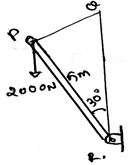Test: Radius Of Gyration Of An Area - Mechanical Engineering MCQ
14 Questions MCQ Test - Test: Radius Of Gyration Of An Area
In the calculation of the radius of gyration, we use intensity of loadings. So whenever the distributed loading acts perpendicular to an area its intensity varies __________
The radius of gyration is related to moment of the body. So the calculation of the moment of the body due to the loadings involve a quantity called ____________
Find the moment of the force about the point R.

How far from the shaft at P a 200N vertical force must act so as to create the same moment as produced by the 75N, at P?
Moment of Inertia is the integration of the square of the distance of the centroid and the del area along the whole area of the structure and this moment is at a distance from the rotating axis, known as radius of gyration.
There is perpendicular axis theorem for the calculation of radius of gyration.
Radius of gyration is indirectly to the parallel axis theorem. The parallel axis theorem gives the moment of inertia ______________ to the surface of considesrance.
The parallel axis theorem can add any angle varied moment of inertias to give the perpendicular moment of inertia and the radius of gyration can be calculated.
As radius of gyration is indirectly to the parallel axis theorem, parallel axis theorem uses the ____________ of the distance.
The distance in the parallel axis theorem is multiplied by:
One of the use of the centre of mass or centroid is as in the radius of gyration is that the net force acts at the ___________ of the loading body.
If the non-Uniform loading is of the type of parabola then for calculating the radius of gyration?
If any external force also is applied on the structure and we are determining radius of gyration then what should we consider?
The body is sometimes acted by two or three force members and we need to find radius of gyration for the same. The difference between the two and the three force members is:



















